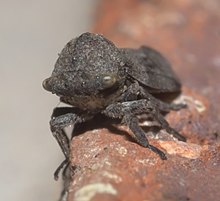Microcentrus
| Microcentrus | ||||||||||||
|---|---|---|---|---|---|---|---|---|---|---|---|---|

Microcentrus caryae (Fitch, 1851) |
||||||||||||
| Systematics | ||||||||||||
|
||||||||||||
| Scientific name | ||||||||||||
| Microcentrus | ||||||||||||
| Stål , 1869 |
Microcentrus is a genus of humpback chirps from the subfamily of the Stegaspidinae . There are currently 18 known species, but some only of one sex. Some species have even been described after only one individual ( M. cyclocarinatus, M. diabolus, M. incomptus, M. lunatus, M. vespertiliauris ). Most species are distributed in Mexico and the USA, some south to Ecuador ( Nearctic and Neotropical ). The northern distribution extends to southern Canada, about 44 ° latitude.
features
The Microcentrus chirps are inconspicuous, robust and make a compact impression. They are 5.1 to 9.0 mm long (from head to wing tip), mostly brown or gray, more or less light in color. Often the males differ from the females ( sexual dimorphism ). The head is broad, about twice as wide as it is high. The pronotum often has no or only weakly developed outgrowths; a median ridge is always formed. In some species (e.g. M. perditus ) two short lateral "horns" are formed. Only the rearward extension is always present; but short, slim and wavy. The fore wings are long, semi-transparent, their nerves are strong and more or less punctured. There are five apical cells and three discoidal cells. The tarsi of the hind legs are longer than those of the other legs.
Types and distribution
(to)
- M. alius , Mexico
- M. astales , Costa Rica, Ecuador
- M. caryae , USA, Canada
- M. cornutus , Mexico
- M. cucullatus , Panama, Ecuador
- M. cyclocarinatus , Costa Rica
- M. diabolus , Mexico
- M. incomptus , Costa Rica
- M. lunatus , Mexico
- M. lynx , Mexico, USA
- M. nicholi , USA, Mexico
- M. perditus , Canada, USA
- M. pileatus , Guatemala, Honduras
- Proximus muscle , Guatemala, Mexico
- M. solussidus , USA, Mexico
- M. sordidus , Mexico
- M. vespertiliauris , Mexico
- M. webbi , Mexico
biology
The chirps always live individually, as far as is known, they mostly live on trees or bushes ( Juglandaceae , Fagaceae , Lauraceae , Pinaceae ) and suck plant sap . Some species only occur on one tree species.
The larvae, so far as we know them, are flat and very difficult to find on the bark on which they live; they are very well camouflaged by their color and structure. The larvae often live on thin twigs or branches. The species that have been described from Ecuador were found by fogging the tops of jungle trees (Canopy Fogging Project).
Web links
Individual evidence
- ↑ a b c d e J. R. Cryan, JA Robertson, LL Deitz: The New World treehopper tribe Microcentrini (Hemiptera, Membracidae, Stegaspidinae): monographic revision and phylogenetic position . In: Ent. Soc. At the. (Ed.): Thomas Say Publicatons in Entomology: Monographs . 2003, ISBN 0-938522-99-X , pp. 1-108 .
- ↑ Treehoppers: Aetalionidae, Melizoderidae, and Membracidae (Hemiptera). Retrieved February 16, 2018 .
- ^ A b C. Godoy, X. Miranda & K. Nishida: Treehoppers of tropical America . Ed .: Instituto national de Biodiversidad, Santo Domingo de Heredia, Costa Rica. 2006, ISBN 9968-927-10-4 , pp. 1-352 .
